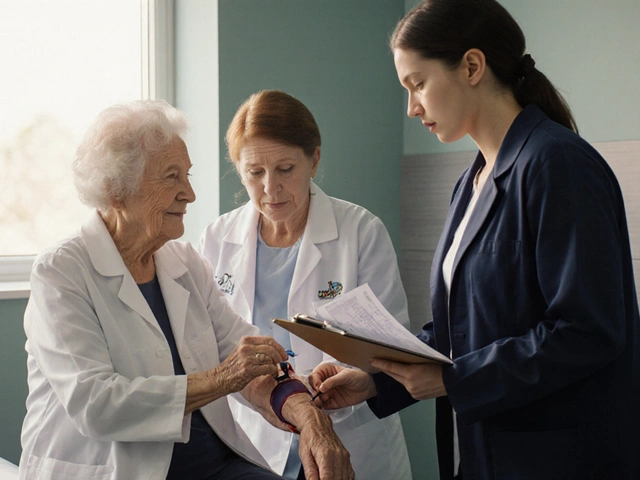CLL Treatment Decision Guide for Older Adults
Treatment Recommendation:
Treatment Options:
When you hear chronic lymphocytic leukemia is a slow‑growing blood cancer that mainly affects the white blood cells called lymphocytes, you might picture a disease that strikes any age. In reality, more than 80% of new CLL cases are diagnosed in people over 60, so the disease is tightly linked to the aging population. This article breaks down what CLL means for older adults, how doctors decide on treatment, and what everyday steps can improve quality of life.
Why CLL Shows up later in life
Research from the International CLL Consortium shows the median age at diagnosis is 71. The reasons are twofold. First, the genetic mutations that trigger CLL accumulate over decades, a phenomenon called genomic aging. Second, routine blood work becomes more common after retirement, catching silent cases that would otherwise stay hidden.
How doctors spot CLL in seniors
The diagnostic pathway is straightforward but requires a few key steps:
- Routine blood count reveals an unexplained rise in white blood cells.
- Flow cytometry confirms the cells are mature B‑lymphocytes.
- Genetic tests (FISH or next‑generation sequencing) identify risk‑associated mutations such as del(13q) or TP53.
Older patients often have comorbidities that mask symptoms, so doctors rely heavily on lab numbers rather than visible signs.
What symptoms actually look like
Because CLL grows slowly, many seniors feel fine for years. When symptoms appear, they usually include:
- Unexplained fatigue that doesn’t improve with rest.
- Swollen lymph nodes, especially in the neck or underarms.
- Occasional night sweats or mild fevers.
- Easy bruising or frequent infections.
These signs often overlap with age‑related conditions, which is why a thorough work‑up matters.
Deciding when to treat - the “watch‑and‑wait” approach
For many older adults, doctors recommend observation rather than immediate therapy. This strategy, known as "watchful waiting," avoids unnecessary side effects. Criteria for starting treatment include:
- Rapidly rising lymphocyte count.
- Significant weight loss or night sweats.
- Organ enlargement that threatens function.
- Genetic markers indicating high risk, such as TP53 loss.
If any of these red flags appear, the care team moves to the treatment decision matrix.

Treatment options tailored for seniors
When therapy is needed, doctors weigh effectiveness against tolerance. Below is a quick snapshot of the most common choices for patients 65 and older.
| Approach | Typical Age Range | Key Benefits | Common Side Effects | Administration |
|---|---|---|---|---|
| Watchful waiting | Any | Avoids drug toxicity | None (monitoring only) | Regular blood tests every 3‑6months |
| Chemo‑immunotherapy (e.g., bendamustine+rituximab) | 65‑80 | Rapid disease control | Neutropenia, infections, fatigue | IV infusions every 28days |
| BTK inhibitors (ibrutinib, acalabrutinib) | 70‑85 | Oral, continuous response | Bleeding, atrial fibrillation, diarrhea | Daily pill |
| Venetoclax‑based regimens | 70‑90 | High response in TP53‑mutated disease | Tumor lysis syndrome, neutropenia | Oral, ramp‑up schedule |
Targeted oral agents have reshaped care for seniors because they spare many of the harsh reactions seen with traditional chemotherapy. However, they still demand close monitoring for heart rhythm changes and drug interactions, especially when patients take multiple prescriptions for hypertension or arthritis.
Living with CLL - quality‑of‑life tips
Beyond the medical plan, everyday habits make a huge difference. Here are practical ideas that older adults can adopt:
- Stay active: Light walking, chair yoga, or tai chi keep the immune system alert without overexertion.
- Eat a balanced diet: Focus on lean protein, colorful vegetables, and whole grains. Vitamin D supplementation is common in seniors and may help bone health.
- Vaccinate wisely: Flu and COVID‑19 shots reduce infection risk; discuss timing with the oncologist because some vaccines work better when the disease is stable.
- Manage medications: Use a single pill organizer, and ask the pharmacist to flag any interaction with CLL drugs.
- Seek support: Local CLL support groups, online forums, and counseling services provide emotional relief and practical advice.
When fatigue spikes, a short nap or a relaxed reading session often restores energy better than pushing through the day.
Financial considerations for older patients
Healthcare costs rise sharply after 65, and CLL treatments can add to the burden. Medicare typically covers most prescription drugs after the PartD deductible, but out‑of‑pocket expenses for targeted pills can still reach several hundred dollars a month. Many patients qualify for patient‑assistance programs offered by drug manufacturers; a social worker can help fill the paperwork.
Looking ahead - research trends
Ongoing clinical trials focus on combining BTK inhibitors with venetoclax to achieve deeper remissions without chemotherapy. Early data suggest that a fixed‑duration regimen could let seniors stop treatment after two years while staying disease‑free. Another promising avenue is CAR‑T cell therapy, but its intensive preparation makes it a less common choice for the frail elderly.
Frequently Asked Questions
What is the typical life expectancy for an older adult diagnosed with CLL?
Life expectancy varies widely. Many seniors live 10‑15years after diagnosis, especially if the disease is low‑risk and managed with watchful waiting. High‑risk genetics or aggressive disease can shorten survival, but newer targeted therapies have improved outcomes across the board.
Can an older person safely take BTK inhibitors if they have heart problems?
BTK inhibitors can raise the risk of atrial fibrillation. Patients with pre‑existing heart disease should have a cardiology review before starting therapy. In many cases, dose adjustments or switching to a newer, less‑cardiotoxic BTK inhibitor works well.
How often should blood tests be done for someone on watchful waiting?
Most clinicians order a complete blood count every three to six months. If the count climbs quickly, the interval shortens to every one to two months.
Are there diet restrictions for people taking venetoclax?
Venetoclax can cause tumor lysis syndrome, so doctors often advise a low‑potassium, low‑phosphate diet during the ramp‑up phase. After the dose stabilizes, most patients resume a normal balanced diet.
What support resources are available for seniors with CLL?
National CLL societies, local hospice groups, and hospital-based patient navigators all offer counseling, medication assistance, and peer‑to‑peer meetings. Online platforms like the CLL Support Forum also host moderated discussion boards for older adults.


Xavier Hernandez
Honestly, tossing around vague buzzwords about 'quality of life' without a solid plan is just plain irresponsible. The elderly deserve a treatment roadmap that balances efficacy with the brutal reality of comorbidities. Ignoring the nuanced data on BTK inhibitors in patients over 70 is tantamount to medical negligence. Let's stop sugar‑coating and start demanding evidence‑based protocols.
Zach Yeager
We should be proud that our doctors finally recognize that older folks aren't just disposable statistics they need aggressive options that keep our nation strong and healthy no more half‑measures let’s push for the best therapies now
Angel Gallegos
The article does a decent job summarizing the epidemiology of CLL in seniors, but it barely scratches the surface of why the disease predominates in this age group. Genomic aging is not a mere buzzword; it reflects a cumulative burden of DNA damage that accelerates after the sixth decade. Moreover, the piece glosses over the fact that many older patients are already on polypharmacy regimes, which dramatically alters drug metabolism. When prescribing BTK inhibitors, clinicians must account for CYP3A4 interactions, a detail the guide omits with careless brevity. The recommendation to monitor blood counts every three to six months is also overly simplistic for high‑risk TP53‑mutated cases. Current guidelines suggest a tighter surveillance interval, sometimes as often as monthly, especially when lymphocyte counts are volatile. I also find the treatment matrix confusing; the flowchart fails to prioritize patient‑reported outcomes such as functional status and frailty scores. These geriatric assessment tools have been validated and should inform whether a patient can tolerate chemo‑immunotherapy versus an oral agent. The article’s tone appears to assume a one‑size‑fits‑all model, which is antithetical to personalized medicine. While the discussion of Venetoclax’s tumor lysis risk is accurate, it neglects the practical dietary modifications needed during the ramp‑up phase. A simple low‑potassium, low‑phosphate regimen can be the difference between a safe initiation and a life‑threatening emergency. Additionally, the financial section barely mentions the existence of patient assistance programs, which are a lifeline for many Medicare beneficiaries. Ignoring these programs not only underestimates the economic burden but also risks non‑adherence due to cost. Finally, the article could benefit from citing the latest phase‑III trials that demonstrate superior progression‑free survival with fixed‑duration BTK‑Venetoclax combos. Such data would give clinicians a stronger evidence base to justify deviating from indefinite therapy. In short, the guide is a helpful starter, yet it demands substantial augmentation before it can truly serve the senior CLL community.
ANTHONY COOK
True, the push for aggressive therapy sounds patriotic, but we must remember the individual’s tolerance, especially heart‑related side effects ☺️. The data on atrial fibrillation with BTK inhibitors isn’t negligible, and older patients deserve a measured approach.
Sarah Aderholdt
When we contemplate medicine, we must balance the science with the lived experience of aging, honoring both survival and dignity.
Phoebe Chico
Indeed, weaving wisdom into treatment plans is like painting a sunrise with the hues of hope and realism – a masterpiece that respects the patient’s narrative while embracing cutting‑edge science.
Larry Douglas
According to the latest NCCN guidelines, patients over 70 with TP53 mutations are preferentially offered Venetoclax in combination with a BTK inhibitor, primarily due to the superior overall response rate observed in the CLL14 trial. The pharmacokinetic profile of Venetoclax necessitates a gradual dose escalation to mitigate tumor lysis syndrome, a protocol that is meticulously outlined in the FDA’s prescribing information. Moreover, drug‑drug interaction studies highlight the necessity of reviewing concomitant CYP3A4 substrates, a common scenario in polypharmacy‑laden geriatric cohorts. Surveillance intervals for complete blood counts should be adjusted based on disease kinetics; a rapid lymphocyte rise warrants a bi‑monthly schedule rather than the standard quarterly approach. These nuances underscore the importance of individualized care beyond the generic recommendations presented.
Michael Stevens
Great rundown! I’d add that many patients find comfort in setting small, achievable activity goals – a short walk or light gardening can really boost morale while they’re on treatment.
Erin Johnson
Oh sure, because juggling chemo and Medicare is just a weekend hobby.
Rica J
lol u r right but fr the med costs are insane i hear u need a 2nd job just to afford the pills.
Linda Stephenson
Has anyone explored how tele‑health follow‑ups impact adherence to oral CLL therapies in rural seniors? I’m curious if virtual check‑ins can reduce the burden of frequent lab visits.
Andrea Dunn
Maybe the pharma giants are pushing those expensive pills on us so they can keep us dependent while the real cure is being hidden in plain sight 😒.
Ann Campanella
Honestly, the guide reads like a buzzword bingo; it needs real patient stories instead of endless tables.